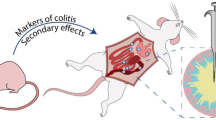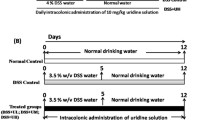Abstract
Objective and design
Angiotensin-converting enzyme 2 (ACE2) is expressed in gastrointestinal tissue. Previous studies of GL1001, a potent and selective ACE2 inhibitor, have revealed anti-inflammatory activity in the mouse digestive tract. We hypothesized that GL1001 might also produce beneficial effects in a mouse DSS model of inflammatory bowel disease.
Materials
Female mice were used for study.
Treatment
Animals were treated for 5 days with 5% DSS in the drinking water to induce colitis. For the following 9 days, animals were treated twice daily with GL1001 (30, 100, 300 mg/kg, s.c.), sulfasalazine (150 mg/kg, p.o.), or vehicle.
Methods
Throughout the experiment, body weight, rectal prolapse, stool consistency, and fecal occult blood were monitored. At termination, colon length, histopathology, and myeloperoxidase activity were assessed.
Results
High-dose GL1001 ameliorated DSS-induced disease activity, including rectal prolapse and intestinal bleeding. The most robust effect of GL1001 was observed 48–96 h post DSS treatment and was comparable in magnitude to that of sulfasalazine. Colon pathology and myeloperoxidase activity were also markedly attenuated by high-dose GL1001 treatment, with the most profound effects observed in the distal segment.
Conclusions
The findings support the previously observed anti-inflammatory effects of ACE2 inhibition in gastrointestinal tissue and suggest that GL1001 may have therapeutic utility for inflammatory bowel disease.





Similar content being viewed by others
Abbreviations
- IBD:
-
Inflammatory bowel disease
- DSS:
-
Dextran sodium sulfate
- Ang:
-
Angiotensin
- Ang I:
-
Angiotensin I
- Ang II:
-
Angiotensin II
- ACE:
-
Angiotensin-converting enzyme
- ACE2:
-
Angiotensin-converting enzyme 2
- AT1 :
-
Angiotensin II receptor type 1
- AT2 :
-
Angiotensin II receptor type 2
- RAS:
-
Renin-angiotensin system
- DAI:
-
Disease activity index
- NSAID:
-
Nonsteroidal anti-inflammatory drug
- MPO:
-
Myeloperoxidase
- TNF-α:
-
Tumor necrosis factor α
References
Loftus EV. Clinical epidemiology of inflammatory bowel disease: Incidence, prevalence, and environmental influences. Gastroenterol. 2004;126:1504–17.
Podolsky DK. Inflammatory bowel disease. N Engl J Med. 2002;347:417–29.
Cho JH. The genetics and immunopathogenesis of inflammatory bowel disease. Nat Rev. 2008;8:458–66.
Katz JA. Management of inflammatory bowel disease in adults. J Dig Dis. 2007;8:65–71.
Derijks LJ, Gilissen LP, Hooymans PM, Hommes DW. Review article: thiopurines in inflammatory bowel disease. Aliment Pharmacol Ther. 2006;24:715–29.
Kozuch PL, Hanauer SB. General principles and pharmacology of biologics in inflammatory bowel disease. Gastroenterol Clin N Am. 2006;35:757–73.
Donoghue M, Hsieh F, Baronas E, Godbout K, Gosselin M, Stagliano N, et al. A novel angiotensin-converting enzyme-related carboxypeptidase (ACE2) converts angiotensin I to angiotensin 1–9. Circ Res. 2000;87:1–9.
Tipnis SR, Hooper NM, Hyde R, Karran E, Christie G, Turner AJ. A human homolog of angiotensin converting enzyme: cloning and functional expression as a captopril-insensitive carboxypeptidase. J Biol Chem. 2000;275:33238–43.
Lambert DW, Hooper NM, Turner AJ. Angiotensin-converting enzyme 2 and new insights into the renin-angiotensin system. Biochem Pharmacol. 2008;75:781–6.
Vickers C, Hales P, Kaushik V, Dick L, Gavin J, Tang J, et al. Hydrolysis of biological peptides by human angiotensin-converting enzyme-related carboxypeptidase (ACE2). J Biol Chem. 2002;277:14838–43.
Gurley SB, Coffman TM. Gene targeting studies of ACE2 in cardiovascular physiology: mixed messages. Exp Physiol. 2008;93:538–42.
Oudit GY, Crackower MA, Backx PH, Penninger JM. The role of ACE2 in cardiovascular physiology. Trends Cardiovasc Med. 2003;13:93–101.
Hamming I, Cooper ME, Haagmans BL, Hooper NM, Korstanje R, Osterhaus ADME, et al. The emerging role of ACE2 in physiology and disease. J Pathol. 2007;212:1–11.
Hamming I, Timens W, Bulthuis MLC, Lely AT, Navis GJ, van Goor H. Tissue distribution of ACE2 protein, the functional receptor for SARS coronavirus: a first step in understanding SARS pathogenesis. J Pathol. 2004;203:631–7.
Harmer D, Gilbert M, Borman R, Clark KL. Quantitative mRNA expression profiling of ACE 2, a novel homologue of angiotensin converting enzyme. FEBS Lett. 2002;532:107–10.
Gembardt F, Sterner-Kock A, Imboden H, Spalteholz M, Reibitz F, Schultheiss HP, et al. Organ-specific distribution of ACE2 mRNA and correlating peptidase activity in rodents. Peptides. 2005;26:1270–7.
Hirasawa K, Sato Y, Hosoda Y, Yamamoto T, Hanai H. Immunohistochemical localization of angiotensin II receptor and local renin-angiotensin system in human colonic mucosa. J Histochem Cytochem. 2002;50:275–82.
Malstrom S, Tyler S, Ellard C, Collins H, Coopersmith R, Barnes T, White D, Tartaglia L. Use of in vivo bio-photonic imaging to identify novel therapeutic utility for use of the ACE2 inhibitor GL1001 for treating inflammatory disorders of the gastrointestinal tract. Paper presented at IBC 13th annual world congress, drug discovery & development of innovative therapeutics 2008 Aug; Boston, MA.
Malstrom S, Ellard C, Collins H, Coopersmith B, Barnes T, White D, Dimitrov L, Tartaglia L. Using in vivo biophotonic imaging in the repositioning of an ACE2 inhibitor. Paper presented at GTCbio conference, imaging in preclinical and clinical drug development 2007 Mar; Boston, MA.
Dales NA, Gould AE, Brown JA, Calderwood EF, Guan B, Minor CA, et al. Substrate-based design of the first class of angiotensin-converting enzyme-related carboxypeptidase (ACE2) inhibitors. J Am Chem Soc. 2002;124:11852–3.
Guzman LM, Odate S, Boiselle CA, Gross SB, Wallace JL, Coopersmith R, et al. GL1001 inhibition of ACE2 is gastroprotective in rat models of gastritits. Inflamm Bowel Dis. 2008;S14:S14.
Okayasu I, Hatakeyama S, Yamada M, Ohkusa T, Inagaki Y, Nakaya R. A novel method in the induction of reliable experimental acute and chronic ulcerative colitis in mice. Gastroenterology 1990;98:694–702.
Somersalo K, Salo OP, Bjorksten F, Mustakalio KK. A simplified Boyden chamber assay for neutrophil chemotaxis based on quantitation of myeloperoxidase. Anal Biochem. 1990;185:238–42.
Axelsson LG, Landstrom E, Bylund-Fellenius AC. Experimental colitis induced by dextran sulfate sodium in mice: beneficial effects of sulphasalazine and olsalazine. Aliment Pharmacol Ther. 1998;12:925–34.
Murthy S, Flanigan A. Animal models of inflammatory bowel disease. In: Morgan DW, Marshall LA, editors. In vivo models of inflammation. Basel: Birkhauser-Verlag, 1999. p. 205–29.
Werner U, Szelenyi I. Measurement of MPO activity as model for detection of granulocyte infiltration into different tissues. Inflamm Res. 1992;36:C101–3.
Duggan KA, Mendelsohn FAO, Levens NR. Angiotensin receptors and angiotensin I-converting enzyme in rat intestine. Am J Physiol Gastrointest Liver Physiol. 1989;257:G504–10.
Paul M, Mehr AP, Kreutz R. Physiology of local renin-angiotensin systems. Physiol Rev. 2006;86:747–803.
Jaszewski R, Tolia V, Ehrinpreis MN, Bodzin JH, Peleman RR, Korlipara R, et al. Increased colonic mucosal angiotensin I and II concentrations in Crohn’s colitis. Gastroenterol. 1990;98:1543–8.
Matsuda T, Suzuki J, Furuya K, Masutani M, Kawakami Y. Serum angiotensin I-converting enzyme is reduced in Crohn’s disease and ulcerative colitis irrespective of genotype. Am J Gastroenterol. 2001;96:2705–10.
Katada K, Yoshida N, Suzuki T, Okuda T, Mizushima K, Takagi T, et al. Dextran sulfate sodium-induced acute colonic inflammation in angiotensin II type 1a receptor deficient mice. Inflamm Res. 2008;57:84–91.
Spencer AU, Yang H, Hazhija EQ, Wildhaber BE, Greenson JK, Teitelbaum DH. Reduced severity of a mouse colitis model with angiotensin converting enzyme inhibition. Dig Dis Sci. 2007;52:1060–70.
Santiago OI, Rivera E, Ferder L, Appleyard CB. An angiotensin II receptor antagonist reduces inflammatory parameters in two models of colitis. Regul Pept. 2008;146:250–9.
Ruiz-Ortega M, Lorenzo O, Suzuki Y, Ruperez M, Egido J. Proinflammatory actions of angiotensins. Curr Opin Nephrol Hypertens. 2001;10:321–9.
Dagenais NJ, Jamali F. Protective effects of angiotensin II interruption: evidence for anti-inflammatory actions. Pharmacotherapy. 2005;25:1213–29.
Guimaraes S, Pinheiro H. Functional evidence that in the cardiovascular system AT1 angiotensin II receptors are AT1B prejunctionally and AT1A postjunctionally. Cardiovasc Res. 2005;67:208–15.
Georgsson J, Rosenstrom U, Wallinder C, Beaudry H, Plouffe B, Lindeberg G, et al. Short pseudopeptides containing turn scaffolds with high AT2 receptor affinity. Bioorg Med Chem. 2006;14:5963–72.
Fyhrquist F, Saijonmaa O. Renin-angiotensin system revisited. J Intern Med. 2008;264:224–36.
Rosenstrom U, Skold C, Lindeberg G, Botros M, Nyberg F, Hallberg A, et al. Synthesis and AT2 receptor-binding properties of angiotensin II analogues. J Pept Res. 2004;64:194–201.
Han S, Wang G, Qiu S, de la Motte C, Wang HQ, Gomez G, et al. Increased colonic apelin production in rodents with experimental colitis and in humans with IBD. Regul Pept. 2007;142:131–7.
Peracchi M, Bardella MT, Caprioli F, Massironi S, Conte D, Valenti L, et al. Circulating ghrelin levels in patients with inflammatory bowel disease. Gut. 2006;55:432–3.
Sanger GJ. Motilin, ghrelin and related neuropeptides as targets for the treatment of GI diseases. Drug Discov Today. 2008;13:234–9.
Granado M, Priego T, Martin AI, Villanúa MA, López-Calderón A. Anti-inflammatory effect of the ghrelin agonist growth hormone-releasing peptide-2 (GHRP-2) in arthritic rats. Am J Physiol Endocrinol Metab. 2005;288:486–92.
Waseem T, Duxbury M, Ito H, Ashley SW, Robinson MK. Exogenous ghrelin modulates release of pro-inflammatory and anti-inflammatory cytokines in LPS-stimulated macrophages through distinct signaling pathways. Surgery. 2008;143:334–42.
Brzozowski T, Konturek PC, Konturek SJ, Kwiecien S, Drozdowicz D, Bielanski W, et al. Exogenous and endogenous ghrelin in gastroprotection against stress-induced gastric damage. Regul Pept. 2004;120:39–51.
Gonzalez-Rey E, Chorny A, Delgado M. Therapeutic action of ghrelin in a mouse model of colitis. Gastroenterology. 2006;130:1707–20.
Lee DK, George SR, O’Dowd BF. Unravelling the roles of the apelin system: prospective therapeutic applications in heart failure and obesity. Trends Pharmocol Sci. 2006;27:190–4.
Chun HJ, Ali ZA, Kojima Y, Kundu RK, Sheikh AY, Agrawal R, et al. Apelin signaling antagonizes Ang II effects in mouse models of atherosclerosis. J Clin Invest. 2008;118:3343–54.
Kleinz MJ, Davenport AP. Emerging roles of apelin in biology and medicine. Pharmacol Ther. 2005;107:198–211.
Author information
Authors and Affiliations
Corresponding author
Additional information
Responsible Editor: I. Ahnfelt-Rønne.
Rights and permissions
About this article
Cite this article
Byrnes, J.J., Gross, S., Ellard, C. et al. Effects of the ACE2 inhibitor GL1001 on acute dextran sodium sulfate-induced colitis in mice. Inflamm. Res. 58, 819–827 (2009). https://doi.org/10.1007/s00011-009-0053-3
Received:
Revised:
Accepted:
Published:
Issue Date:
DOI: https://doi.org/10.1007/s00011-009-0053-3




